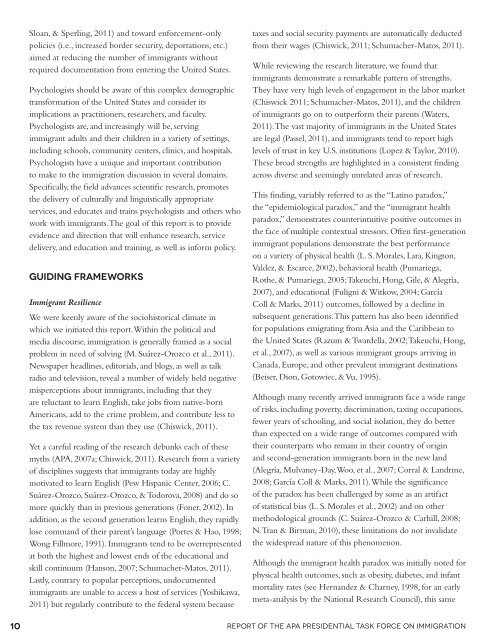Crossroads: The Psychology of Immigration in the New Century
Crossroads: The Psychology of Immigration in the New Century
Crossroads: The Psychology of Immigration in the New Century
Create successful ePaper yourself
Turn your PDF publications into a flip-book with our unique Google optimized e-Paper software.
Sloan, & Sperl<strong>in</strong>g, 2011) and toward enforcement-only<br />
policies (i.e., <strong>in</strong>creased border security, deportations, etc.)<br />
aimed at reduc<strong>in</strong>g <strong>the</strong> number <strong>of</strong> immigrants without<br />
required documentation from enter<strong>in</strong>g <strong>the</strong> United States.<br />
Psychologists should be aware <strong>of</strong> this complex demographic<br />
transformation <strong>of</strong> <strong>the</strong> United States and consider its<br />
implications as practitioners, researchers, and faculty.<br />
Psychologists are, and <strong>in</strong>creas<strong>in</strong>gly will be, serv<strong>in</strong>g<br />
immigrant adults and <strong>the</strong>ir children <strong>in</strong> a variety <strong>of</strong> sett<strong>in</strong>gs,<br />
<strong>in</strong>clud<strong>in</strong>g schools, community centers, cl<strong>in</strong>ics, and hospitals.<br />
Psychologists have a unique and important contribution<br />
to make to <strong>the</strong> immigration discussion <strong>in</strong> several doma<strong>in</strong>s.<br />
Specifically, <strong>the</strong> field advances scientific research, promotes<br />
<strong>the</strong> delivery <strong>of</strong> culturally and l<strong>in</strong>guistically appropriate<br />
services, and educates and tra<strong>in</strong>s psychologists and o<strong>the</strong>rs who<br />
work with immigrants. <strong>The</strong> goal <strong>of</strong> this report is to provide<br />
evidence and direction that will enhance research, service<br />
delivery, and education and tra<strong>in</strong><strong>in</strong>g, as well as <strong>in</strong>form policy.<br />
Guid<strong>in</strong>g Frameworks<br />
Immigrant Resilience<br />
We were keenly aware <strong>of</strong> <strong>the</strong> sociohistorical climate <strong>in</strong><br />
which we <strong>in</strong>itiated this report. With<strong>in</strong> <strong>the</strong> political and<br />
media discourse, immigration is generally framed as a social<br />
problem <strong>in</strong> need <strong>of</strong> solv<strong>in</strong>g (M. Suárez-Orozco et al., 2011).<br />
<strong>New</strong>spaper headl<strong>in</strong>es, editorials, and blogs, as well as talk<br />
radio and television, reveal a number <strong>of</strong> widely held negative<br />
misperceptions about immigrants, <strong>in</strong>clud<strong>in</strong>g that <strong>the</strong>y<br />
are reluctant to learn English, take jobs from native-born<br />
Americans, add to <strong>the</strong> crime problem, and contribute less to<br />
<strong>the</strong> tax revenue system than <strong>the</strong>y use (Chiswick, 2011).<br />
Yet a careful read<strong>in</strong>g <strong>of</strong> <strong>the</strong> research debunks each <strong>of</strong> <strong>the</strong>se<br />
myths (APA, 2007a; Chiswick, 2011). Research from a variety<br />
<strong>of</strong> discipl<strong>in</strong>es suggests that immigrants today are highly<br />
motivated to learn English (Pew Hispanic Center, 2006; C.<br />
Suárez-Orozco, Suárez-Orozco, & Todorova, 2008) and do so<br />
more quickly than <strong>in</strong> previous generations (Foner, 2002). In<br />
addition, as <strong>the</strong> second generation learns English, <strong>the</strong>y rapidly<br />
lose command <strong>of</strong> <strong>the</strong>ir parent’s language (Portes & Hao, 1998;<br />
Wong Fillmore, 1991). Immigrants tend to be overrepresented<br />
at both <strong>the</strong> highest and lowest ends <strong>of</strong> <strong>the</strong> educational and<br />
skill cont<strong>in</strong>uum (Hanson, 2007; Schumacher-Matos, 2011).<br />
Lastly, contrary to popular perceptions, undocumented<br />
immigrants are unable to access a host <strong>of</strong> services (Yoshikawa,<br />
2011) but regularly contribute to <strong>the</strong> federal system because<br />
taxes and social security payments are automatically deducted<br />
from <strong>the</strong>ir wages (Chiswick, 2011; Schumacher-Matos, 2011).<br />
While review<strong>in</strong>g <strong>the</strong> research literature, we found that<br />
immigrants demonstrate a remarkable pattern <strong>of</strong> strengths.<br />
<strong>The</strong>y have very high levels <strong>of</strong> engagement <strong>in</strong> <strong>the</strong> labor market<br />
(Chiswick 2011; Schumacher-Matos, 2011), and <strong>the</strong> children<br />
<strong>of</strong> immigrants go on to outperform <strong>the</strong>ir parents (Waters,<br />
2011). <strong>The</strong> vast majority <strong>of</strong> immigrants <strong>in</strong> <strong>the</strong> United States<br />
are legal (Passel, 2011), and immigrants tend to report high<br />
levels <strong>of</strong> trust <strong>in</strong> key U.S. <strong>in</strong>stitutions (Lopez & Taylor, 2010).<br />
<strong>The</strong>se broad strengths are highlighted <strong>in</strong> a consistent f<strong>in</strong>d<strong>in</strong>g<br />
across diverse and seem<strong>in</strong>gly unrelated areas <strong>of</strong> research.<br />
This f<strong>in</strong>d<strong>in</strong>g, variably referred to as <strong>the</strong> “Lat<strong>in</strong>o paradox,”<br />
<strong>the</strong> “epidemiological paradox,” and <strong>the</strong> “immigrant health<br />
paradox,” demonstrates counter<strong>in</strong>tuitive positive outcomes <strong>in</strong><br />
<strong>the</strong> face <strong>of</strong> multiple contextual stressors. Often first-generation<br />
immigrant populations demonstrate <strong>the</strong> best performance<br />
on a variety <strong>of</strong> physical health (L. S. Morales, Lara, K<strong>in</strong>gton,<br />
Valdez, & Escarce, 2002), behavioral health (Pumariega,<br />
Ro<strong>the</strong>, & Pumariega, 2005; Takeuchi, Hong, Gile, & Alegría,<br />
2007), and educational (Fuligni & Witkow, 2004; García<br />
Coll & Marks, 2011) outcomes, followed by a decl<strong>in</strong>e <strong>in</strong><br />
subsequent generations. This pattern has also been identified<br />
for populations emigrat<strong>in</strong>g from Asia and <strong>the</strong> Caribbean to<br />
<strong>the</strong> United States (Razum & Twardella, 2002; Takeuchi, Hong,<br />
et al., 2007), as well as various immigrant groups arriv<strong>in</strong>g <strong>in</strong><br />
Canada, Europe, and o<strong>the</strong>r prevalent immigrant dest<strong>in</strong>ations<br />
(Beiser, Dion, Gotowiec, & Vu, 1995).<br />
Although many recently arrived immigrants face a wide range<br />
<strong>of</strong> risks, <strong>in</strong>clud<strong>in</strong>g poverty, discrim<strong>in</strong>ation, tax<strong>in</strong>g occupations,<br />
fewer years <strong>of</strong> school<strong>in</strong>g, and social isolation, <strong>the</strong>y do better<br />
than expected on a wide range <strong>of</strong> outcomes compared with<br />
<strong>the</strong>ir counterparts who rema<strong>in</strong> <strong>in</strong> <strong>the</strong>ir country <strong>of</strong> orig<strong>in</strong><br />
and second-generation immigrants born <strong>in</strong> <strong>the</strong> new land<br />
(Alegría, Mulvaney-Day, Woo, et al., 2007; Corral & Landr<strong>in</strong>e,<br />
2008; García Coll & Marks, 2011). While <strong>the</strong> significance<br />
<strong>of</strong> <strong>the</strong> paradox has been challenged by some as an artifact<br />
<strong>of</strong> statistical bias (L. S. Morales et al., 2002) and on o<strong>the</strong>r<br />
methodological grounds (C. Suárez-Orozco & Carhill, 2008;<br />
N. Tran & Birman, 2010), <strong>the</strong>se limitations do not <strong>in</strong>validate<br />
<strong>the</strong> widespread nature <strong>of</strong> this phenomenon.<br />
Although <strong>the</strong> immigrant health paradox was <strong>in</strong>itially noted for<br />
physical health outcomes, such as obesity, diabetes, and <strong>in</strong>fant<br />
mortality rates (see Hernandez & Charney, 1998, for an early<br />
meta-analysis by <strong>the</strong> National Research Council), this same<br />
10 Report <strong>of</strong> <strong>the</strong> APA Presidential Task Force on <strong>Immigration</strong>
















